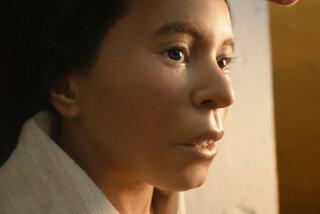Modern Medicine for Ancient Mummies
- Share via
ATLANTA — Researchers at Emory University are using the same technology to find and diagnose disease in the living and discover the secrets of the dead.
Using computer tomography scans of 10 Egyptian mummies acquired by the school’s Michael C. Carlos Museum in 1999, the scientists are gathering information that could not otherwise be obtained without destroying or unwrapping the bodies.
One of the mummies might be Ramses I, founder of Egypt’s 19th dynasty and ruler between 1292 and 1290 BC.
“We put the mummy just like a patient on the table and into the CT machine,” said Heidi Hoffman, a resident in radiology at Emory and one of the authors of a report on the research.
The machine generates a number of cross-sectional images, or visual slices, of the mummies. The visuals are then fed into a computer program that creates three-dimensional images of the mummified bodies and allows for what Hoffman calls a fly-through, which gives the viewer an impression of going inside the mummy itself.
Although she had no background in Egyptology or archeology, Hoffman said she leaped at the opportunity to research the mummies.
“My standard as a doctor has been a normal human body, so when I first looked at these CT scans, I said, ‘What the heck am I looking at?’ ” she said by phone from Chicago, where she presented a paper on the findings at the Radiological Society of North America convention in November.
Among their conclusions, Hoffman and her colleagues say the appearance and posture of one of the bodies and the embalming methods used could mean that it is that of Ramses I, grandfather of Ramses II or Ramses the Great.
If it is, said James Harris, a retired professor of orthodontia at the University of Michigan who has studied the royal mummies in Cairo since the 1960s, it would be a “huge contribution” to the field of Egyptology.
“Right now, we have a gap after the end of the 18th dynasty,” he said. “We have, for example, the mummy of Tutankhamen, but then nothing until Seti I, who was the son of Ramses I.”
Hoffman said the mummy, which arrived at the museum with its head almost completely unwrapped, bears an uncanny resemblance to images of Seti and Ramses II.
“The high cheekbones and other facial features are similar,” she said.
Although it might be questionable to base such a claim on subjective visual assessments of facial features, Harris said precise measurements and numerous facial X-rays show that the mummy’s bone structure is similar enough to that of other royal mummies to indicate common ancestry.
“I think it’s a good possibility this mummy is Ramses I, especially if it can be shown to come from the right period of time,” Harris said. “That’s really the key to the whole puzzle.”
Carbon dating could pinpoint the time within a range of 40 years, Harris said.
Officials at the Carlos Museum hope eventually to use DNA testing to identify the mummy.
Hoffman said the mummy’s arms were crossed over the chest in a pose used only on royalty or nobility. The skull was emptied of brains and filled with a costly embalming resin.
Resin was also found in the mummy’s abdomen, which had been emptied of organs and filled with tightly rolled linen packs, an embalming practice Hoffman said was used during the period when Ramses I lived.
Emily Teeter, curator of Egyptian antiquities at the Oriental Institute, University of Chicago, said such evidence doesn’t go far enough to prove that the mummy is Ramses I.
“That’s completely non-diagnostic,” she said. “We have a bunch of non-royal mummies, and some have crossed arms. And filling the skull with resin was standard embalming procedure.”
But Teeter, who first began using CT scans to study mummies in 1991, admits that she was also struck by the resemblance to Ramses II and said further study--especially DNA evidence--may prove that Emory’s mummy is the famous patriarch.
Whatever the conclusion, the research has converted Hoffman to an enthusiastic Egyptologist.
“It’s opened up a whole new field and facet of radiology for me,” she said.
*
Michael C. Carlos Museum: https://www.cc.emory.edu/CARLOS/
Radiological Society of North America: https://www.rsna.org/






